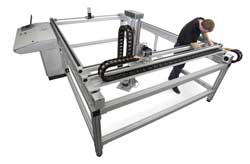
Posted to News on 17th Jun 2008, 15:13
Festo supplies bespoke gantry robot for university research
Working to a brief from researchers at Manchester University's School of Materials, Festo has supplied a custom-designed 3D gantry robot for creating components from carbon fibre tow.

Manchester University's School of Materials, in conjunction with Festo, has created an innovative robotic placement machine for carbon fibre ply. Intended to serve as a development platform, it looks set to establish new standards in carbon fibre manufacturing. The machine, which is based entirely on Festo electrical drives and controls, has a three-dimensional operating envelope and is capable of laying carbon fibre tow very flexibly, at a rate of up to 8m/s.
Carbon fibre composites are traditionally constructed by laying a number of unidirectional or woven pre-impregnated (prepreg) plies over a tool mould and then curing them with heat in an autoclave. An alternative, less widely used method, involves the use of dry fabric plies and a resin infusion process. These techniques are widely regarded as very inefficient and expensive - they can have material wastage levels as high as 40 per cent.
Technology developments are constantly improving in this field and one major development is a process known as near-net shaping, an approach used with various industrial materials where the whole production process is geared to the final (net) shape of the product. Near-net shaped carbon fibre processes involve laying down precise lengths of tow with the right orientation for the specific product. This orientation is the key: many components require higher strength in one direction and, by laying the fibres accurately and in defined patterns, the component cross-section is reduced and the strength-to-weight ratio is improved. It is also a much more efficient process, with raw material wastage levels as low as 1-2 per cent. Until now, however, it has been much slower than traditional techniques.
Aerospace applications
The Textile Composites Group at the University of Manchester is actively pursuing the near-net shaping approach, with particular reference to the specific needs of the aerospace industry. Dr Prasad Potluri, Reader in Textile Composites, comments: "We were looking for new ways of laying tow in predefined patterns. For the aerospace industry, we needed to develop lab-scale processes for products that can be 3m long and 2m wide, with a height of up to 500mm. So we required equipment capable of operating on a large scale and with great precision, which could also handle heavy spools of carbon fibre tow. We were also looking for fast operation, so the equipment had to be highly automated."
Already the carbon fibre industry uses machinery that can take advantage of near-net shaped technology, but the costs run into millions of pounds, and the systems do not provide the flexibility and development potential sought by Dr Potluri. So the Group decided to develop its own system. Funding came from Northwest Composite Centre, which was set up by the Northwest Regional Development Agency as part of its commitment to dynamic and sustainable economy for the North West of England.
With funding in place, the next step was to find an automation specialist capable of designing and delivering the three-dimensional spatial gantry system that would form the heart of the Textile Composite Group's new machine. Dr Potluri explains: "We are specialists in carbon fibre production, not robotics. We chose Festo because of the company's sheer range of motors and drives. We just specified our requirements, and Festo built a complete motion solution, right down to the control system and the software to operate it. Festo personnel also programmed and commissioned the system, and trained our post-graduate PhD students on its use. As a result, we had a working solution up and running with minimum risk and hassle."
Machine performance
The new Robotic Tow Placement machine is capable of tow-laying speeds of up to 8m/s and has a three-dimensional operating envelope. It incorporates two parallel 3m long belt actuators and a pair of 2m long belt actuators, with a vertical 600mm ball screw drive for the Z axis. The actuators are driven by Festo synchronous AC servo motors and drives, and controlled from a central control cabinet. The control system incorporates a facility for DXF drawing import, to allow simple programming of complex 3D motion using the axes.
Dr Potluri states: "We expect to be laying tow automatically on the machine and testing new processes and technologies within six months. We will have up to three graduates developing on the machine, helping companies in the aerospace arena make high-tech products for the future. And as well as developing new laying techniques on the machine, we will be looking at new methods of consolidating carbon fibres instead of the traditional autoclave - for example, we have a curing method using the Quickstep process from Australia, which uses a liquid heating system rather than air heating in an autoclave."






























